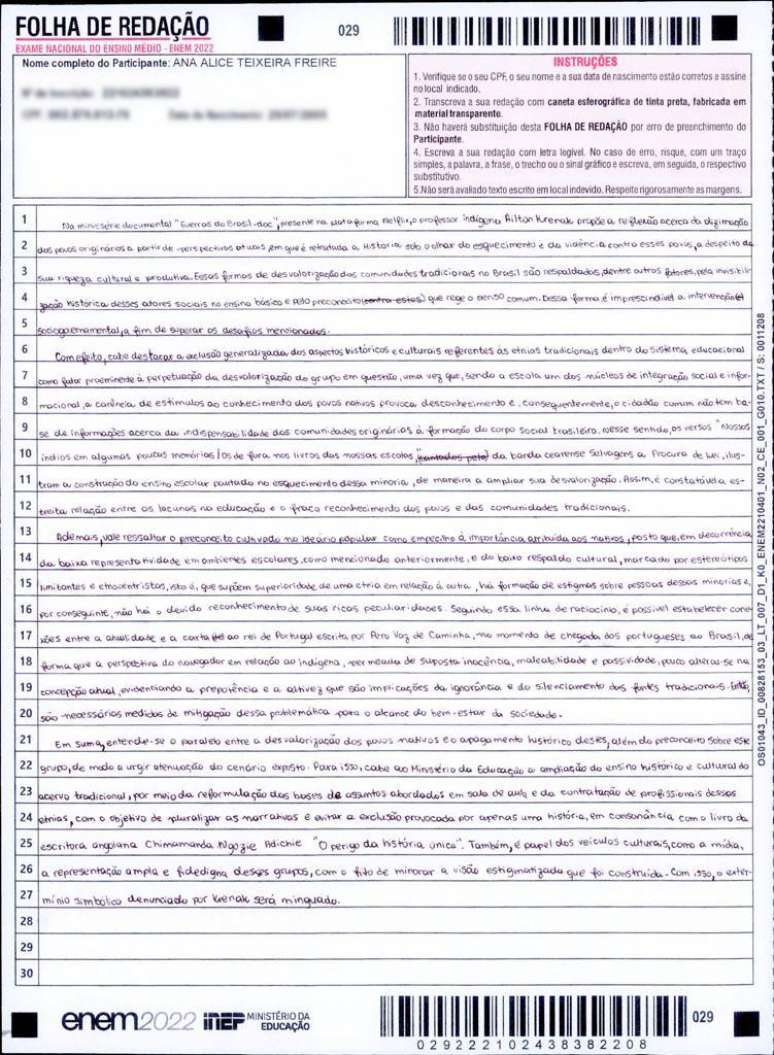The mini-series “Guerras do Brasil.doc”, reflecting the main armed conflicts in the history of the country, was used as a repertoire in the text
Ana Alice Teixeira Freire, 17, was one of the candidates who obtained a score of 1000 in the Enem 2022 essay. The student from Fortaleza (CE), who is now studying journalism at the Federal University of Ceará (UFC), presented a rich cultural repertoire on the theme proposed in the latest edition, “Challenges to enhance traditional communities and peoples in Brazil”. One of the references present in the thesis is a documentary series available on Netflix.
The production, “Guerre do Brasil.doc”, reflects in each episode on an armed conflict of great importance for the history of the country. The author and indigenous activist Ailton Krenak, also mentioned by the student in the text, is the interviewee in the first episode, in which he analyzes different perspectives of the Portuguese colonization.
+ Who is Ailton Krenak, an Indigenous writer who has joined the Unicamp list
To analyze the textual choices of the student, the STUDENT GUIDE invited Nelândia Teodoroa writing teacher who taught Ana Alice during her high school at the Colégio Master, in Fortaleza.
“Ana Alice’s writing has many qualities, but, without a doubt, the main one is the excellence of the text project. Prospective candidates should observe the candidate’s writing process, as it is quite stimulating,” says the professor. A golden tip to do well in the Enem essay is precisely to read other texts with a maximum score.
Below is the completed student essay and then the teacher’s comments for each paragraph.

introduction
In the documentary miniseries “Guerras do Brasil.doc”, present on the Netflix platform, the indigenous professor Ailton Krenak proposes a reflection on the decimation of indigenous peoples from current perspectives, in which history is portrayed from the perspective of oblivion and violence against these peoples , despite their cultural and productive richness. These forms of devaluation of traditional communities in Brazil are supported, among other factors, by the historical invisibility of these social actors in basic education and by the prejudice that governs common sense. Therefore, socio-governmental intervention is essential to overcome the mentioned challenges.
The introductory paragraph must, very clearly, demonstrate that the candidate has been able to grasp the problematic aspect inserted in the formulation of the written proposal, i.e. the crux of the matter, what, in fact, the editorial board considers a problem. In the case of the proposal inserted in the last Enem, the candidate should explain what hinders the appreciation of traditional communities and peoples in Brazil, such as quilombolas, indigenous people, riverside inhabitants and caiçaras.
Ana Alice has explored, to demonstrate this reading comprehension, a miniseries that presents, in a documentary way, different conflicts that have occurred during the development of Brazil, highlighting what interested her for the discussion of the theme: the violence practiced against the communities and traditions of the peoples and the oblivion to which they were relegated.
To develop his textual project, he highlights, as a factor challenging the appreciation of indigenous peoples, the invisibility of their history in primary schools and the prejudice generated by this invisibility. He also emphasizes that these challenges need to be overcome.
+ Discovery or invasion of Brazil – what you need to know for testing
Note the underlined word in the context of the repertoire that introduced the text. Ana Alice returned to this term throughout the reasoning that she developed in the text. This demonstrates not only an awareness of what good textual design needs to do, but also a perfect notion of the productivity of the sociocultural repertoire. Ana Alice knows exactly what her purpose is in an authorial text.
Development 1
In fact, it is worth highlighting the generalized exclusion of the historical-cultural aspects referring to traditional ethnic groups within the educational system as a pre-eminent factor in the perpetuation of the devaluation of the group in question, since, being the school one of the nuclei of social integration and information, the lack of incentives to knowledge of indigenous peoples causes lack of knowledge and, consequently, the ordinary citizen has no basis of information on the indispensability of the original communities for the formation of the Brazilian social body. In this sense, the verses “Our Indians in some few memories / Strangers in the books of our schools”, by the Ceará musical group Selvagens à Procura da Lei, illustrate a construction of school teaching based on the oblivion of this minority, in order to increase its devaluation. Thus, the close relationship between education gaps and the low recognition of traditional peoples and communities is evident.
Continuing with the textual project begun in the introductory paragraph, Ana Alice explains to the reader how the invisibility of the history of traditional communities and peoples undermines their appreciation. In this explanation you clarify that if the school does not tell its students the story of the original peoples, it will generate a citizen who will not be aware of the importance of these peoples for the country. By addressing the “ordinary citizen,” Ana deftly paves the way for what she will be talking about in Development 2 (this commoner, due to misinformation, will direct prejudice towards native peoples).
She chooses to repertorise the idea of invisibility she developed with the verses of a song that talks: these people are out of school books, so they are only in some of our few memories. Note: if they are out of school books, if they are in some small memory of ours, they are forgotten. Do you remember the underlined word in the context of the introductory repertoire? Ana Alice takes up this idea with this second repertoire and, with it, shows that she knows exactly where she wants to go with her textual project of her. She closes the paragraph by underlining the weakening of a recognition which, according to her, occurs due to educational gaps.
+ Enem: how to get the maximum score in the 5 writing skills
Development 2
Furthermore, it should be noted the prejudice cultivated in popular ideas as an obstacle to the importance attributed to indigenous peoples, since, due to the scarce representation in school environments, as mentioned above, and the scarce cultural support, marked by stereotyped limits and ethnocentrism, that is, which presuppose the superiority of one ethnic group over another, stigma is formed towards people belonging to these minorities and, therefore, there is no recognition of their rich peculiarities. Following this line of reasoning, it is possible to establish links between the present and the letter to the King of Portugal written by Pero Vaz de Caminha, at the time of the arrival of the Portuguese in Brazil, so that the perspective of the navigator in The relationship with the indigenous , permeated with presumed innocence, malleability and passivity, little has changed in the current conception, highlighting the arrogance and pride which are implications of the ignorance and silence of traditional sources. Therefore, measures to mitigate this problem are necessary to achieve the welfare of society.
In Development 2, the candidate spoke of how prejudice undermines the appreciation of the peoples in question and, as already anticipated in the analysis of Development 1, she raised the stigmatization of indigenous peoples as a consequence of the education system without counting their history peoples. The way she combined the two problematizing elements of her thesis – at the beginning of the third paragraph – was, in my view, sensational! You explain that this prejudice exists because there are ethnic groups who feel superior to others and, to foster a better understanding of this ethnocentrism, you used the letter of But Vaz de Caminha to the king of Portugal, a historical moment in which the colonizer already referred to the colonized with the pride that generated this fallacy of the superiority of one ethnic group over the other, which, according to the candidate’s explanation, continues to this day.
+ Enem writing: how brokers analyze the sociocultural repertoire
Conclusion
In short, we understand the parallel between the devaluation of indigenous peoples and their historical erasure, as well as the prejudice against this group, to urge the mitigation of the scenario presented. For this reason, it is up to the Ministry of Education to expand the historical-cultural teaching of the traditional collection, through the reformulation of the basis of the subjects covered in the classroom and the hiring of professionals of these ethnic groups, with the aim of pluralising the narratives and avoiding the exclusion caused by a single story, in line with the book of the Angolan writer Chimamanda Ngozie Adichie “The danger of the single story”. It is also the role of cultural vehicles, such as the media, to provide a broad and faithful representation of these groups, with the aim of debunking the stigmatized view that has been constructed. With this, the symbolic extermination denounced by Krenak will be diminished.
The candidate begins the process of completing the text by returning to the problematic that started the textual project. He brings all the elements required by competence 5, but above all he escapes from clichés. It’s worth looking at the innovation he’s brought about in detail. He chose to detail the purpose, which is rarely seen in the Enem. Boldly, he detailed a well-known work: “The danger of the single story.” And what does he implicitly tell us with this detail? That the school does not give a voice to indigenous peoples.
+ Enem writing: the most common mistakes made in the competence 5
We still have, in Brazil, a unique story, told from the point of view of the colonizer, a haughty, arrogant look, as he said in D2. This obviously challenges the appreciation of traditional communities and peoples. To conclude this excellent topic, the candidate takes up the introductory repertoire, alludes to the speech of a representative of the original peoples and gives voice to the symbolic extermination he denounced. Everything in this text fits together perfectly.
Source: Terra
Rose James is a Gossipify movie and series reviewer known for her in-depth analysis and unique perspective on the latest releases. With a background in film studies, she provides engaging and informative reviews, and keeps readers up to date with industry trends and emerging talents.


![Un Si Grand Soleil Preview: Episode Summary for Tuesday, October 28, 2025 [SPOILERS] Un Si Grand Soleil Preview: Episode Summary for Tuesday, October 28, 2025 [SPOILERS]](https://fr.web.img2.acsta.net/img/cb/ba/cbba991ec6092b42c6fe91c18f33c426.jpg)


